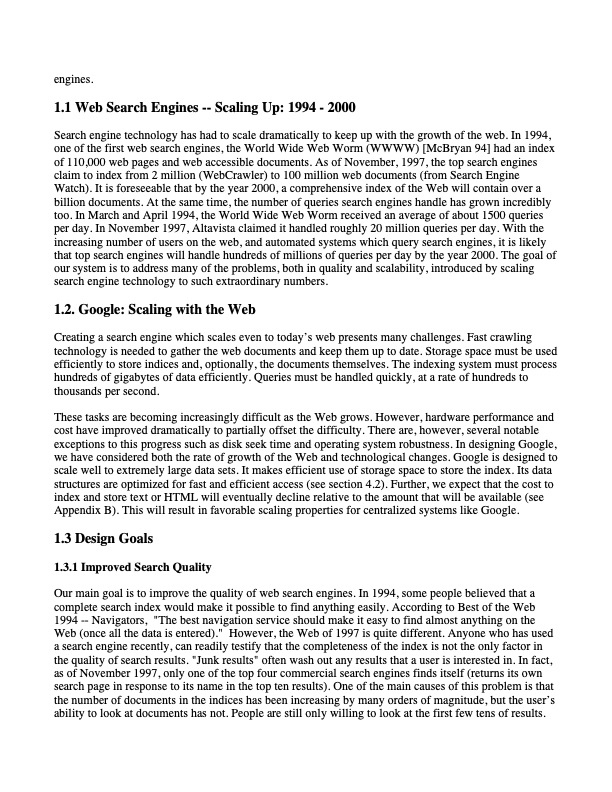
PDF Publication Title:
Text from PDF Page: 002
engines. 1.1 Web Search Engines -- Scaling Up: 1994 - 2000 Search engine technology has had to scale dramatically to keep up with the growth of the web. In 1994, one of the first web search engines, the World Wide Web Worm (WWWW) [McBryan 94] had an index of 110,000 web pages and web accessible documents. As of November, 1997, the top search engines claim to index from 2 million (WebCrawler) to 100 million web documents (from Search Engine Watch). It is foreseeable that by the year 2000, a comprehensive index of the Web will contain over a billion documents. At the same time, the number of queries search engines handle has grown incredibly too. In March and April 1994, the World Wide Web Worm received an average of about 1500 queries per day. In November 1997, Altavista claimed it handled roughly 20 million queries per day. With the increasing number of users on the web, and automated systems which query search engines, it is likely that top search engines will handle hundreds of millions of queries per day by the year 2000. The goal of our system is to address many of the problems, both in quality and scalability, introduced by scaling search engine technology to such extraordinary numbers. 1.2. Google: Scaling with the Web Creating a search engine which scales even to today’s web presents many challenges. Fast crawling technology is needed to gather the web documents and keep them up to date. Storage space must be used efficiently to store indices and, optionally, the documents themselves. The indexing system must process hundreds of gigabytes of data efficiently. Queries must be handled quickly, at a rate of hundreds to thousands per second. These tasks are becoming increasingly difficult as the Web grows. However, hardware performance and cost have improved dramatically to partially offset the difficulty. There are, however, several notable exceptions to this progress such as disk seek time and operating system robustness. In designing Google, we have considered both the rate of growth of the Web and technological changes. Google is designed to scale well to extremely large data sets. It makes efficient use of storage space to store the index. Its data structures are optimized for fast and efficient access (see section 4.2). Further, we expect that the cost to index and store text or HTML will eventually decline relative to the amount that will be available (see Appendix B). This will result in favorable scaling properties for centralized systems like Google. 1.3 Design Goals 1.3.1 Improved Search Quality Our main goal is to improve the quality of web search engines. In 1994, some people believed that a complete search index would make it possible to find anything easily. According to Best of the Web 1994 -- Navigators, "The best navigation service should make it easy to find almost anything on the Web (once all the data is entered)." However, the Web of 1997 is quite different. Anyone who has used a search engine recently, can readily testify that the completeness of the index is not the only factor in the quality of search results. "Junk results" often wash out any results that a user is interested in. In fact, as of November 1997, only one of the top four commercial search engines finds itself (returns its own search page in response to its name in the top ten results). One of the main causes of this problem is that the number of documents in the indices has been increasing by many orders of magnitude, but the user’s ability to look at documents has not. People are still only willing to look at the first few tens of results.PDF Image | natomy of a Large-Scale Hypertextual Web Search Engine

PDF Search Title:
natomy of a Large-Scale Hypertextual Web Search EngineOriginal File Name Searched:
google-anatomy-of-a-search-engine.pdfDIY PDF Search: Google It | Yahoo | Bing
Cruise Ship Reviews | Luxury Resort | Jet | Yacht | and Travel Tech More Info
Cruising Review Topics and Articles More Info
Software based on Filemaker for the travel industry More Info
The Burgenstock Resort: Reviews on CruisingReview website... More Info
Resort Reviews: World Class resorts... More Info
The Riffelalp Resort: Reviews on CruisingReview website... More Info
| CONTACT TEL: 608-238-6001 Email: greg@cruisingreview.com | RSS | AMP |